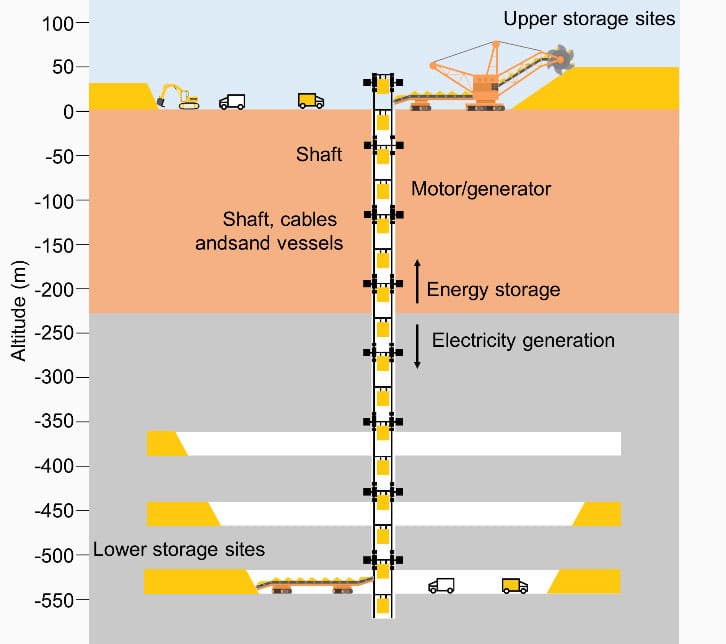Low-carbon energy transitions taking place worldwide are primarily driven by the integration of renewable energy sources such as wind and solar power. These inherently variable and inconsistent renewable energy sources require energy storage options to match energy demand reliably at different time scales.
In a new study, an international team of researchers developed a novel technology to store energy by transporting sand into abandoned underground mines. The technique, called Underground Gravity Energy Storage (UGES), proposes an effective long-term energy storage solution while also making use of now-defunct mining sites, which likely number in the millions globally.
The system generates electricity when the price is high by lowering sand into an underground mine and converting the potential energy of the sand into electricity via regenerative braking and then lifting the sand from the mine to an upper reservoir using electric motors to store energy when electricity is cheap.

The main components of UGES are the shaft, motor/generator, upper and lower storage sites, and mining equipment. The deeper and broader the mineshaft, the more power can be extracted from the plant, and the larger the mine, the higher the plant’s energy storage capacity.
In addition, the energy storage medium of UGES is sand, which means that there is no energy lost to self-discharge, enabling ultra-long time energy storage ranging from weeks to several years.
Researchers estimated that the technology has a global energy storage potential of 7 to 70 TWh, with most of this potential concentrated in China, India, Russia, and the USA.
“When a mine closes, it lays off thousands of workers. This devastates communities that rely only on the mine for their economic output. UGES would create a few vacancies as the mine would provide energy storage services after it stops operations,” says Julian Hunt, a researcher in the IIASA Energy, Climate, and Environment Program and the lead author of the study. “Mines already have the basic infrastructure and are connected to the power grid, which significantly reduces the cost and facilitates the implementation of UGES plants.”
Journal reference:
- Julian David Hunt, Behnam Zakeri, Jakub Jurasz, Wenxuan Tong, Paweł B. Dąbek, Roberto Brandão, Epari Ritesh Patro, Bojan Đurin, Walter Leal Filho, Yoshihide Wada, Bas van Ruijven, and Keywan Riahi. Underground Gravity Energy Storage: A Solution for Long-Term Energy Storage. Energies, 2023; DOI: 10.3390/en16020825
Converting abandoned mines into gravity batteries
Source: Tambay News

0 Comments